Strategies for Navigating a tree with a Fence: Explored in Seven Different Methods
In the quest to protect your property and maintain a beautiful garden, fencing around trees can be a thoughtful solution. This article provides a comprehensive guide on how to build a fence around a tree without causing harm, while also enhancing the aesthetic appeal of your yard.
Constructing a Custom Fence for Your Tree
When building a fence around a tree, it's essential to respect its space. You can achieve this by leaving clearance around the trunk and roots, and by using a variety of fence designs. Options include constructing a fence with posts spaced away from the tree’s base and connecting horizontal rails or pickets around it, or using a trellis-style fence that can both protect the tree and add aesthetic value.
Key Considerations
Avoiding damage to roots during post installation, ensuring the fence does not hinder the tree’s access to sunlight and water, and allowing room for future growth are crucial factors to consider.
Benefits of Fencing Around a Tree
Preserving the tree’s ecological value, shade, and aesthetic contribution to your yard, as well as maintaining soil stability, are significant advantages of fencing around a tree rather than removing it. Careful placement avoids stressing or damaging the tree’s roots, which are critical to its health.
Practical Tips
- Leave enough space around the trunk to prevent constriction and root damage.
- Use a design (like picket, split rail, or trellis fences) suited to your property and style preference.
- Avoid driving posts too close to roots; consider hand digging to locate roots if unsure.
- Plan for uneven ground or slopes if present.
- Maintain the fence and tree to allow healthy growth without conflict.
Other Techniques and Solutions
Using the tree as a fence post, curving the fence around the tree, creating windows in the fence, pollarding the tree, coppicing the tree, and adjusting the fence height are various techniques that can help you go around a tree with a fence without cutting it down.
Coppicing and Pollarding: Ancient Techniques for Tree Management
Coppicing and pollarding are ancient techniques used for managing trees. Coppicing involves cutting the tree back to the ground and allowing it to regrow from the stump, while pollarding is a pruning method for trees that involves cutting about 8 feet or upwards up the trunk, keeping only a few branches at the desired length to allow for regrowth.
Making Design Choices to Accommodate the Tree
If the tree interrupts the fence close to the ground level, creating windows in the fence can let the tree pass through. If the upper branches of a tree block the fence at a certain point, you could adapt the fence’s height so that the upper edge stays underneath the branches in that region.
The Choice of Method Depends on Factors such as the Tree, Aesthetic Sense, Fencing Purposes, and Legal Factors
The choice of method depends on factors such as the tree, its roots, aesthetic sense, fencing purposes, and legal factors like property boundaries. For instance, coppicing is effective if the tree interrupts the fence close to the ground level, as with large trees or those with sharply bent trunks. Pollarding is a good option when the fence is high, and the upper branches are the only parts of the tree interrupting the fence line.
In conclusion, fencing around a tree is a thoughtful and environmentally friendly solution that balances protecting your property and fence function with respecting and preserving your tree’s health and beauty.
[Author's Bio] Glen, a gardening expert with over 15 years of experience in garden maintenance, design, and landscaping services, has recently published articles on garden fungicides, candy cane peppers, and watermelons.
A fusion of various fence designs, such as picket, split rail, or trellis, can be utilized to enhance the aesthetic appeal of home-and-garden landscapes while also sheltering individual trees.
Careful design choices, like including windows in the fence or adjusting the fence's height, can accommodate existing trees without causing harm and maintain the overall lifestyle appeal of a home-and-garden space.




